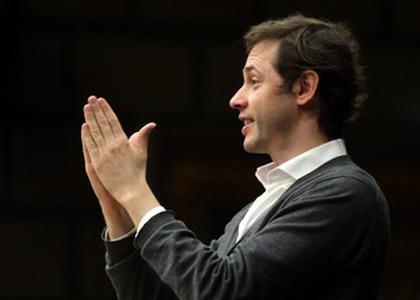> Interviews

Interview with conductor Maxime Pascal
Tonight, November 8th, 2024, the "George Enescu" Philharmonic Orchestra reprises the program performed last night at the Romanian Athenaeum. In light of this event, returning to the podium with the Bucharest ensemble is Maxime Pascal, founder of the "Le Balcon" ensemble. The French musician shared insights on his reunion with the Romanian audience and the concert program in an interview with our colleague, Ioana Țintea.
Maxime Pascal, your innovative approach to classical music sets you apart from traditional conductors. How do you feel the audience responds to this vision?
I am very focused on my role as a conductor, which is to support the musicians-instrumentalists, orchestra, singers-and help them give their best for the audience, bringing what's written in the scoreto life with attention to every detail. So, I'm not sure whether or not my methods are innovative; what matters is to succeed in sharing this experience with the audience.
Let's talk about the program you're presenting to the audience at the Romanian Athenaeum-Maurice Ravel's opera L'Heure espagnole (The Spanish Hour) in concert version, paired with Nikolai Rimsky-Korsakov's symphonic suite Scheherazade. What inspired you to bring these works together?
The Spanish Houris Ravel's first opera; he had already composed Scheherazade for soprano and orchestra, which was a space for the French composer to experiment with new sounds, instrumental possibilities, and orchestration techniques. In The Spanish Hour, he introduces numerous orchestral effects that significantly influenced later composers, inspiring them to explore a variety of sound effects. Scheherazade by Rimsky-Korsakov was one of the main works that influenced Ravel, Debussy, and Stravinsky, serving as a prototype for works like Ravel's Daphnis and Chloé or Stravinsky's The Rite of Spring. In Rimsky-Korsakov's orchestration for Scheherazade, we find fundamental concepts related to instruments and orchestration techniques that later shaped the styles of Ravel and Debussy. It's well known that Ravel was fascinated by Rimsky-Korsakov's work and his orchestration treatise. The two pieces share a similar approach, making them wonderful to perform together, as a way of highlighting how music and orchestration evolve from Rimsky-Korsakov to Ravel in closely related styles.
In the concert presentation of these operas, each orchestral musician becomes a vital character in the unfolding of the musical narrative. How is your collaboration with the Bucharest Philharmonic ensemble going?
I conducted The Spanish Hour in an opera house with the orchestra in the pit, and I must say it's challenging to grasp all the intricate details that Ravel writes, since they're so complex and precise. The orchestra works like an elaborate mechanism, like a grand clock filled with gears and sound effects. With Ravel's music, you feel as if you're actually inside this mechanism. When the orchestra is on stage, the entire experience morphs into a soundscape, a true sonic scenery, as if the singers are performing not just in an opera, but within an acoustic universe. It's extraordinary, and working with this orchestra is fantastic. The ensemble's sound is truly special-the musicians create an incredible atmosphere full of colour and expressiveness. When I listen to the orchestra in this hall, I feel the sound itself coming to life. It's truly wonderful.
Photo credit: Cătălina Filip
Translated by Andreea-Nicoleta Ban,
University of Bucharest, Faculty of Foreign Languages and Literatures, MTTLC, year I
Corrected by Silvia Petrescu














